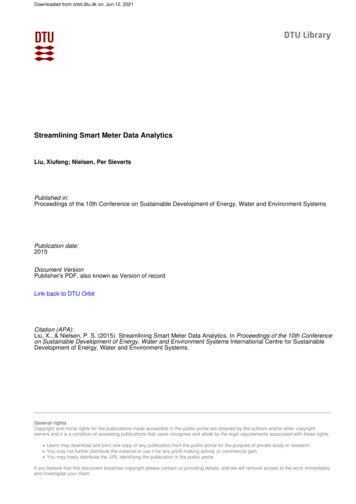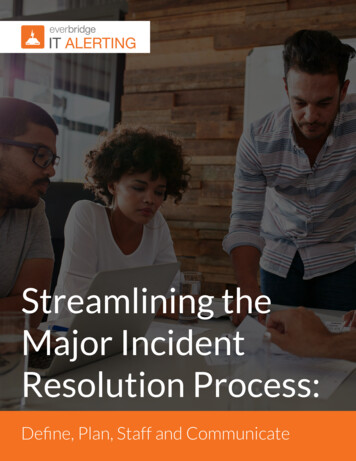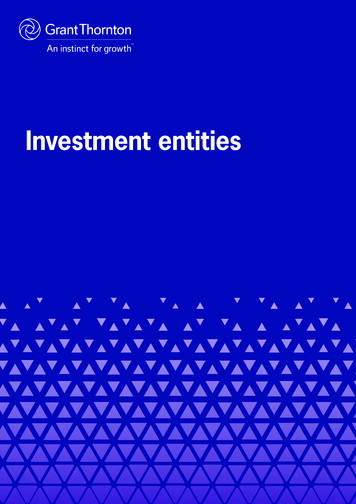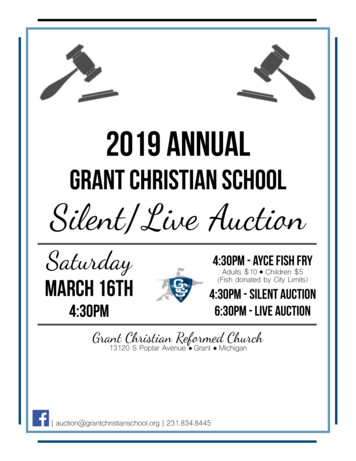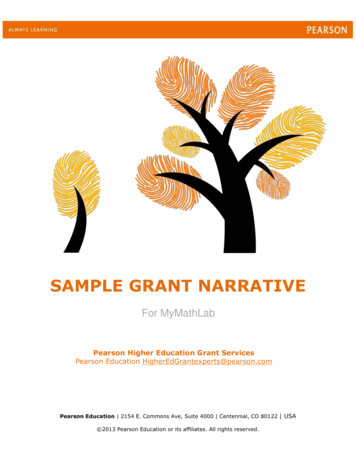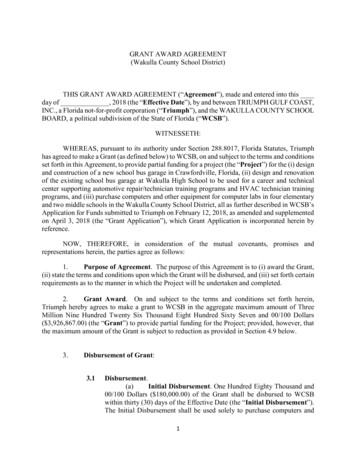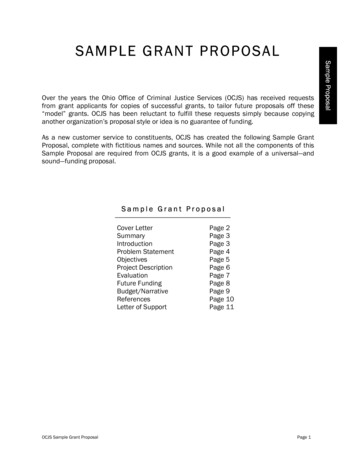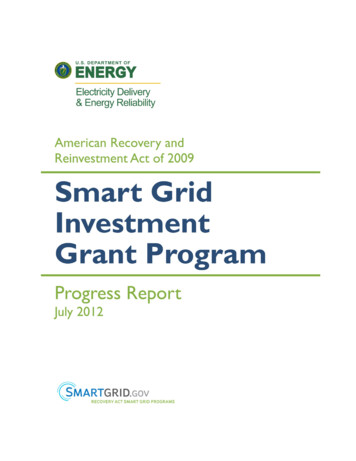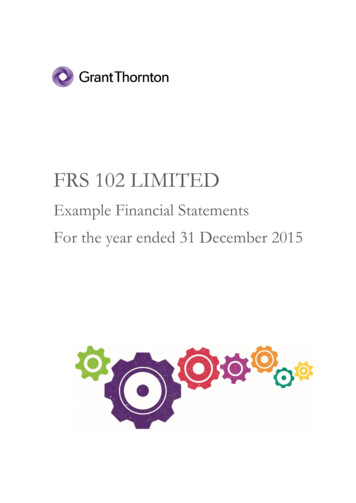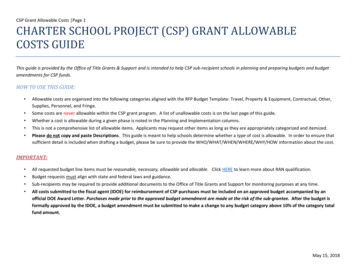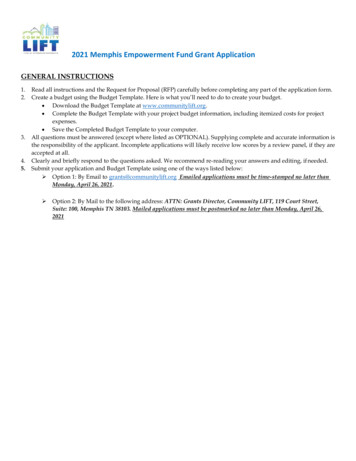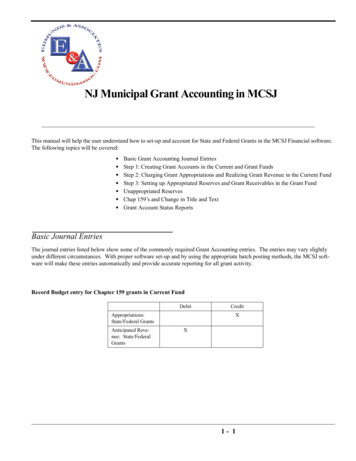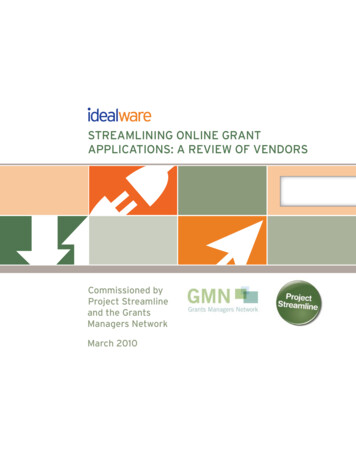
Transcription
Streamlining Online GrantApplications: A Review of VendorsCommissioned byProject Streamlineand the GrantsManagers NetworkMarch 2010
Table of ContentsIntroduction.4The Criteria for Comparison.5How Do The Vendors Compare?. 10EasyGrants by Altum.13eGrant.net by Bromelkamp.17WebGrants by Dulles Technology Partners . 21Grant Lifecycle Manager by Foundant Technologies. 24IGAM by MicroEdge.27Common Grant Application, by Ocean Peak. 30PhilanTrack by PhilanTech. 34Appendix A: How We Rated the Products. 38Appendix B: About The Authors. 42PAGE2Streamlining Online Grant Applications: A Review of Vendors March 2010
AuthorsLaura S. Quinn, IdealwareChris Bernard, italics mediaFor more information about the authors, please see Appendix B.About Project StreamLineProject Streamline is an effort of funders and nonprofits to improve grant application, monitoring and reportingpractices. It is a collaborative initiative of the Grants Managers Network, in partnership with the Association ofFundraising Professionals, the Association of Small Foundations, the Council on Foundations, the Forum ofRegional Associations of Grantmakers, the Foundation Center, Grantmakers for Effective Organizations, andthe National Council of Nonprofits. For more information, go to www.projectstreamline.org.About The Grants Managers NetworkThe Grants Managers Network (GMN) improves grantmaking by advancing the knowledge, skills and abilities ofgrants management professionals and leading grantmakers to adopt and incorporate effective practices thatbenefit the philanthropic community. GMN has more than 1,400 members from 1,000-plus grantmaking organizations who represent the breadth of the philanthropic community, including small family foundations, prominentnational foundations, grantmaking public charities and socially responsible corporations. For more information, goto www.gmnetwork.org.About IdealwareIdealware, a 501(c)(3) nonprofit, provides thoroughly researched and impartial resources about software to helpnonprofits make smart software decisions. By synthesizing vast amounts of original research and informationinto credible and approachable resources, Idealware helps nonprofits make the most of their time and financialresources. For more information, go to www.idealware.org.PAGE3Streamlining Online Grant Applications: A Review of Vendors March 2010
IntroductionOnline grant application systems can be a timesaverfor all involved—or they can cause grantseekers andgrantmakers alike to tear out their hair in frustration.Clearly, these systems represent an advancementover paper applications, but the degree to which theyactually provide a good experience varies significantlyfrom system to system.In this report, weevaluate seven differentvendors againstProject Streamline’sEssential and GoldStandard features foronline applications andreporting.also included two products—PhilanTrack and Common Grant Application—specifically intended to helpstreamline grant processes. The systems reviewedincluded: EasyGrants by Altum eGrant.net, by Bromelkamp WebGrants by Dulles Technology Partners Grant Lifecycle Manager by Foundant Technologies IGAM by MicroEdge Common Grant Application by Ocean Peak PhilanTrack by PhilanTechWe also invited Cybergrants to be reviewed, but theydeclined to participate in our process.Clearly, our focus for these reviews is quite limited.We’re not aiming to cover every piece of functionalityoffered by these systems—many include robust capabilities around review committees, email communications, payment tracking, reporting, and much more—but to focus in with laser precision on the features thatcan best help reduce the administrative burden of bothgrantseekers and grantmakers.Project Streamline’s Online Applications and Reporting Guide encourages grantmakers to consider thefeatures of the systems from the perspective of theuser. This report does just that. The Online Applications and Reporting Guide outlined a set of Essentialand Gold Standard features for online systems—inthis report we go one step further, evaluating sevendifferent vendors against those features.We chose the grants management tools targeted at awide market, and with a fair number of clients. WePAGE4Streamlining Online Grant Applications: A Review of Vendors March 2010
The Criteria for ComparisonTo most usefully be able to compare these sevensystems, we’ve divided the list of features into aset of high level categories. Each of these categoriessummarizes an important group of Essential andGold Standard features that allows us to comparethe systems on an apples-to-apples basis. Below, wedescribe the categories, and map them to the guidelines from the Project Streamline report.Getting Started: Ease for ApplicantsMost applicants start a grant writing process by reviewing the information that will be required of themand making a plan for how they will write or acquire it.A system that makes it easy to register and see theapplication questions—ideally, complete withcharacter length limits and required fields—eases that process considerably.application at any point in the process and after theycomplete the application.Most applicantsstart a grant writingprocess by reviewingthe information thatwill be required ofthem, and making aplan for how they willwrite or acquire it.This category includes the guidelines:Essential Standard 1. Simple account creationwith lost password functionality. Systems thatrequire applicants to log in should follow standardWeb best practices and include a way to deal with lostpasswords, both at the user level (have password emailed to the user) and at the grantmaker level (in casethe employee that started the application is no longeravailable to complete the application).Essential Standard 2. Ability to preview and printa full application before starting and at any pointbefore submission. It is important to provide a wayfor applicants to preview and print the full applicationform before starting so they can gather the informationthey need and begin working on responses offline.In addition, applicants should be able to print out theirPAGE5Getting Started: Reuse of InformationIt doesn’t make sense for an organizations to re-enterits mailing address on every new application. Systemscan provide for this, and even better, allow organizations to reuse other applicable documents, find andreuse whole questions from prior applications, or evencopy an entire application.This category includes the guidelines:Essential Standard 3. Storage and retrieval of pastdata. Address, contact and organizational history information should be retained so that returning applicants donot have to enter this data with each new application.Streamlining Online Grant Applications: A Review of Vendors March 2010
Essential Standard 4. Duplicate Controls. Onlinesystems should include good controls to ensure thatreturning applicants are not treated as new to the database. The system should check for organization nameas well as the Employer Identification Number (EIN)and name and telephone number for contact people.Gold Standard 1. Access to previously submittedapplications. Applicants should be able to see a history of previously submitted applications, print themout, and use them as a template for new submissions.Overall Applicant Ease of UseSimple features can make a big difference in applicants’ ability to quickly and effectively enter data intothe form. Is it clear what’s expected of them, or whatthey’ve done wrong when there’s an error? Can theypaste in text from a Word document? How easy is it tosave—or to lose—work?Simple features canmake a big differencein applicants’ ability toquickly and effectivelyenter data into the form.This category includes the guidelines:Essential Standard 5. Ability for an applicant tosave work and return to it later. Applicants can’talways complete their application in one session.Essential information may not be at their fingertips.And some applications are completed by more thanone person—e.g., a program staffer and a financialstaffer—both of whom need access to the onlineapplication forms.PAGE6Essential Standard 6. Clear and widespread opportunities to save work. Computers crash and Internet connections get dropped. Getting 95% throughan application and having all the work lost because ofa computer crash can make for a very unhappy grantseeker. Online application systems should provideautomatic saves or regular opportunities to save workmanually during the application process so that inputted text is saved event if the system goes down.Essential Standard 7. Ability to copy and pastetext from word-processed documents into Webforms. Grantseekers often cut and paste answers fromsimilar proposals or from stock language developed todescribe their organization or project. Retyping thoseanswers into a grantmaker’s form wastes time.Essential Standard 8. Required fields. Because oneadvantage of using online application systems is tomake sure grantseekers provide all the necessary information, online application systems should have theability to require that certain fields be filled out. Thesefields should be clearly delineated for the applicant.Essential Standard 9. Error notices. If a requiredfield is not filled out, or if incorrect information isentered (such as text in a numeric field), the onlinesystem should provide clear and simple feedback tothe applicant about what the error is and how to fix it.Essential Standard 10. Word or character counter.Online systems often provide grantmakers the abilityto put word and/or character limits on fields. Thesecan be frustrating to grantseekers filling out the application.If limits are used, the fields should include a counterso that applicants are aware of how much spaceremains as they fill out the application.Essential Standard 11. File attachments. Onlinesystems that allow applicants to include file uploadsshould make this process as simple as possible, follow-Streamlining Online Grant Applications: A Review of Vendors March 2010
ing common Web practices. Clear instructions shouldbe included regarding how to attach a file, what typesof files are acceptable, and what file size limitationsthere are, if any. Virus scanning on all attachmentsshould be done before any files are brought into thedatabase.Essential Standard 12. Acknowledgement ofreceipt of submission. All online systems shouldgenerate an e-mail to applicants letting them knowthat their application was received. These emailsshould be customizable to allow the grantmaker toinclude information the applicant will need to followup on the grant request, such as a request number,staff member to contact for more information,and next steps in the review process.Good Form Design:Self-Service CreationMany grantmakers’ programs and evaluation criteriachange over time. For these organizations, it’s veryuseful to have a user-friendly set of tools to help create and edit application and status report forms.This category includes the guideline:Essential Standard 14. Online forms editing Online forms should be easy for foundation staff to edit,improve instructions or incorporate suggestions, andmake the online process easier and more user-friendly.As this feature is often important to grantmakers,and is a big differentiator between the systems,we felt it was worth a category of its own.Good Form Design:Flexibility of FormsSome systems make it easy to create polished formsthat are easy to parse and fill out. With others, it’san uphill battle. How easy is it to add advanced fields,PAGE7Some systems make iteasy to create polishedforms that are easy toparse and fill out.or categories? Can you ask a set of questions of onlya particular set of applicants?This category includes the guidelines:Essential Standard 13. Good design Good designand layout can make or break the usability of anonline application system. This requires grant application design tools that allow the creator of a form togroup fields into categories, include hyperlinks, andincorporate at least basic HTML design elements likeunderlining, centering and bolding text.Essential Standard 15. Drop-down lists, checkboxes and radio buttons Online forms should havethe ability to include drop-down lists, check boxes andradio buttons to preserve data integrity in the databaseand keep it simple for the applicant.Gold Standard 2. Branch logic In eligibility quizzes,letters of inquiry, and full proposals, it is very useful tobe able to include branch logic—e.g., if applying forthis type of grant, then one set of criteria applies; ifapplying for another type of grant, a different set ofcriteria applies. This allows applicants to easily answeronly the questions that are appropriate to them.Gold Standard 3. Advanced design capabilitiesGold-standard systems use full Web design tools toallow for true flexibility in the creation of forms andmultimedia “Web 2.0” features.Streamlining Online Grant Applications: A Review of Vendors March 2010
Support for Multiple StagesMany grantmakers require more than one online form.Eligibility quizzes, Letters of Intent (LOIs), proposals and status reports are all important parts of manygrantmaking processes.Grantseekers shouldbe able to easilyconvert an LOI-stageapplication into a fullproposal online formwithout having to reenter their information.This category includes the guidelines:Essential Standard 16. Support for eligibility quizzes.Grantmakers should provide clear and easily accessibleguidelines on what they do or don’t fund. An eligibilityquiz that takes the applicant through a simple set ofquestions can be an excellent tool to reinforce theseguidelines. It can also save the applicant the time ofapplying for a project that has no chance of beingfunded and the grantmaker the time of reviewing anineligible request. Ideally, quiz functionality shouldinclude the ability to automatically check the Officeof Foreign Asset Control (OFAC) list and verify501(c)(3) status (via the IRS or Guidestar), as appropriate to the grantmaker’s needs, as well as provideapplicants the specific reason for ineligibility.PAGE8Essential Standard 17. Online reporting. Systemsshould allow applicants to submit interim and finalreports online. This would include providing a granteewith their responses to the original proposal questionsand allowing them to report on the outcomes andsubmit attachments. Upon submission, the data shouldfeed back into the grants management database so thatthe grantmaker has a complete record of the grantfrom proposal through final report.Gold Standard 4. Multiple-stage applications.Systems should allow grantmakers to define multipleonline application stages, including an eligibility quiz, aLetter of Inquiry or Intent (LOI), and a full-proposal.Grantseekers should be able to easily convert anLOI-stage application into a full proposal online formwithout having to re-enter their information.Information Sharing: CollaborationIdeally, a grantmaking process should be a collaboration between a grantmaker and a grantseeker, withinformation shared in both directions.This category includes the guidelines:Gold Standard 5. Application editing and collaboration. It’s useful for grantseekers and grantmakers tobe able to work collaboratively on a pending application until it is completed. For example, an applicantcan be working on a proposal that the funder canaccess, make suggestions for edits, and work withthe grantseeker to refine before final submission.Gold Standard 6. Extranet capabilities. Beyondthe application process, it’s very useful for applicantsto be able to check on the status of a request online,see when reports will be due and when paymentsare scheduled, and change their contact/addressinformation (with approval control from thefunder organization).Streamlining Online Grant Applications: A Review of Vendors March 2010
Information Sharing: Data Exportand AccessOnline applications, progress reports and even entiregrant management systems don’t exist in isolation.It’s important to be able to export the data fromthe system or, ideally, to allow programmers toaccess the database through their own software.This category includes the guideline:Gold Standard 7. Software should allow datato be written to and from third-party systems.Grantmakers could benefit greatly by taking the bestparts of one system and marrying them with anothersystem or creating their own programs to extendthe capabilities of a grants management database. Inorder to do this, vendors need to offer an applicationprogramming interface, or API, at low cost. The APIwould enable software developers to create programsthat would “talk” to the database. This would allowgrantmakers to create just the look and feel they want,access data in a way that best suits their needs, andprovide a better interface for grantseekers. And, perhaps counter-intuitively, it could also benefit vendorsby allowing them to concentrate their developmentefforts on those things they do best and allowing theircustomers to get what they really want.PAGE9As this guideline varied so much across vendors, wefelt it was worth a category of its own.Product BackgroundLast but not least, we took a look at the history ofthe product. How long has the product been around?How many clients are using it? Using a product that isnewer and has fewer clients increases the risk that thevendor will go out of business.It’s important to be ableto export the data fromthe system or, ideally,to allow programmersto access the databasethrough their ownsoftware.Streamlining Online Grant Applications: A Review of Vendors March 2010
PhilanTrack by PhilantechCommon Grant Application by Ocean PeakIGAM by MicroEdgeWebGrants by DullesMost of the rest of the report is devoted to detailed reviews of each of these systems, but beforewe dive in, let’s take a summary look at each.eGrants.net by BromelkampFor information on exactly how these ratings weredetermined see Appendix A: How We Determined the Ratings.EasyGrants by AltumAll of these systems had some strong abilitiesto streamline the grantseeking and grantmakingprocess—but of course, the strengths and weaknesses varied across the systems.Grant Lifecycle Manager by FoundantHow Do The Vendors Compare?Getting Started: Ease for ApplicantsGetting Started: Reuse of InformationOverall Applicant Ease of UseGood Form Design: Self Service CreationGood Form Design: Flexibility of FormsSupport for Multiple StagesInformation Sharing: CollaborationInformation Sharing: Data Export and AccessProduct BackgroundNonePAGE10FairStreamlining Online Grant Applications: A Review of Vendors March 2010SolidExcellent
EasyGrants by AltumEasyGrants is a powerful but expensive grantsmanagement system with substantial support for complex online applications, status reports and customworkflows, part of a full-featured grants managementsystem. The system is reasonably eas
grants management professionals and leading grantmakers to adopt and incorporate effective practices that . Idealware, a 501(c)(3) nonprofit, provides thoroughly researched and impartial resources about software to help nonprofits make smart software decisions. By synth
